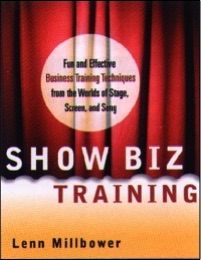Autographed by Lenn
ACT THREE
In Act Three: Stagecraft, we explored the particulars of stagecraft, beginning with Chapter Eight: The Stage. It found us examining the details of the environment that must be in place for magicians and other performers to deliver flawless entertainment. We examined the possible seating arrangements, and their advantages and disadvantages. The elements of the stage were then examined. We looked at the affect of lighting and scenery. We even considered ways in which all five senses might be employed to stage the environment.
Next, in Chapter Nine: Props, we examined the usefulness of props in the learning environment. We discovered that visual representations save explanatory time, and that props can serve as visual memory cues. To help us determine appropriate prop usage in the learning environment, we concluded the chapter with an examination of the OFFBEAT™ Prop Selection Matrix.
In Chapter Ten: The Script and Chapter Eleven: Rehearsal we focused on the performer and continued examining the environment as we learned how entertainers prepare for a performance by scripting and then rehearsing the material scripted. We discovered that entertainment's Three-Act Structure is applicable to the learning environment, and that scripting has distinct advantages.
We then we discussed the correct rehearsal steps. Chapter Twelve: The Performer helped us evaluate our own performance abilities. We looked at our personality traits, our vocal projection ability, our posture and our clothing, and we discussed microphone usage.
Finally, at the beginning of this chapter, we saw an example as Harriet the Housekeeping trainer applied Show Biz Training to her asbestos awareness class. In the process, she created an enjoyable experience that increased learner retention.
We are almost done, but I would like to leave you with two questions to consider:
1. Is your learning so enjoyable that you could charge admission?
2. Would you give a ticket to your training to someone you liked and admired?
If answered, "No" to either of these questions, how do you think your learners feel? And, what are you going to do about it?

Before we begin our finale, let’s review our journey through Show Biz Training.
ACT ONE
Act One: The Info-Fog, focused on the need for Show Biz Training techniques.
In Chapter One: The Distracted Learner, We discovered the info-fog our learners face, and the factors that have caused its existence.
We next, in Chapter Two: The World is a Stage, determined that stories have always been with humans, and that those stories evolved into the entertainment giant we confront today.
We examined the ways in which various entities, advertising, news, business, sports and edutainment have all used entertainment to increase the effectiveness of their messages in Chapter Three: Let Me Entertain You.
With all those factors in mind, we next, in Chapter Four: Learnertainment®, overviewed the ways in which the human brain functions. A special emphasis was focused on the role of survival and emotion, and how those two interact with each other.
We next explored Giorgi Lozanov's Suggestopedia, and its attempt to reach the deep recesses of the brain through relaxed joy. Finally, and most importantly, we examined the Learning Links model, and saw how entertainment directly related to human brain processing. We then were introduced to the eight Learnertainment® Principals.
Through those principals, we explored the entertainment arts. We learned the tools that comedians, musicians and magicians use and discovered ways to apply those tools to the learning environment.
ACT TWO
Act Two: Lessons from Entertainment showcased three major show biz elements: comedy, music, and magic.
In Chapter Five: Lessons from Comedy, we learned the benefits of humor. We examined the joke structures comedian's use. We also discovered that people who laugh together become community, and that an atmosphere of playfulness unleashes positive emotion that makes learning memorable.
We also, in Lessons from Comedy, discovered that comedy works because it presents information on more than one level. It forces a learner to walk all the way around a subject. It generates an understanding deeper than what would be possible with traditional lecture based methods.
In Chapter Six: Lessons from Music, we learned, through movie music, about the auditory signal. We focused on a case study, the extinction of silent films. From that case study, we determined that the auditory signal was too powerful a tool to overlook. And, we examined some templates for applying music to the learning environment.
Music also taught us how critical emotion is in creating a whole experience. We examined the wholeness that music adds to an environment, from shopping centers to the local cinema. In addition, we learned that emotional signals are more likely to be remembered by our brain, and thus aid retention.
From magic, in Chapter Seven: Lessons from Magic, we discovered the power of direction to point the learners towards the outcomes we want them to achieve. We discovered that magicians cheat nature by redefining the events that occur around them. Suggestion was examined at length as a tool for directing learners towards positive outcomes.
Places Please for Effective Instruction with Learnertainment®
